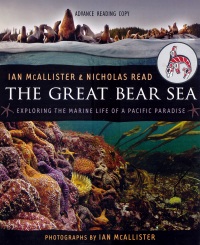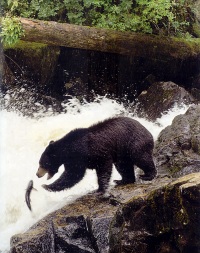| ________________
CM . . .
. Volume XX Number 2. . . .September 13, 2013 
 |
The Great Bear Sea: Exploring the Marine Life of a Pacific Paradise.
Ian McAllister & Nicholas Read. Photographs by Ian McAllister.
Victoria, BC: Orca, 2013.
121 pp., trade pbk, pdf & epub, $19.95 (pbk.).
ISBN 978-1-4598-0019-9 (pbk.), ISBN 978-1-4598-0020-5 (pdf), ISBN 978-1-4598-0521-7 (epub).
Subject Heading:
Marine biology-British Columbia-Great Bear Sea-Juvenile literature.
Grades 4-8 / Ages 9-13.
Review by Gillian Richardson.
**** /4
|
| |
|

excerpt:
The Great Bear Rainforest shoreline is long and varied. There are sandy beaches, mud flats and estuaries where eelgrass – a kind of underwater grass – grows and blooms. But much of the forest shore is rocky, rugged and remote, which is ideal habitat for intertidal creatures.
Many people find it hard to think of barnacles as living things. When they’re crushed together on the surface of a rock in an ugly, knobbly (and really painful if you walk on them with bare feet) carpet, they look like stucco on the side of a house. But barnacles are living creatures. It’s just that when the tide goes out, the creatures inside those tooth like shells stop moving. This is also true of mollusks like oysters, mussels and clams. We know there’s a fleshy, tasty creature inside each of the oyster and mussel shells that decorate Pacific shorelines like plates on a sideboard. But when the tide’s out, who’d know, because all their shells have clammed up.
Bears would. In the Great Bear Rainforest, black bears, grizzlies and spirit bears alike comb the shore for clams, oysters, mussels and barnacles…
If you’ve ever wondered about this special place on Canada’s west coast, you’ll enjoy the remarkable detail of the amazing undersea life that hugs the fringe of the Great Bear Rainforest. This book is a companion to two previous volumes by the same author/photographer pair – The Salmon Bears and The Sea Wolves– in which readers met inhabitants of the rainforest. But the picture isn’t complete without knowledge of the sea dwellers (“The waters off the forest’s rugged coast contain more creatures than the forest itself…”), and how they directly impact life ashore.
The book is organized into nine chapters, detailing sea creatures from smallest (plankton) to largest (whales), and plants that provide nourishment to the whole population. Woven through the facts about various living things are references to how the environment has been affected over time by human inhabitants, contributing to issues like pollution, overfishing and climate change. The Conclusion focuses on the need to protect this sensitive area from the most immediate threat – increased oil tanker traffic with its potential for huge oil spills and increased acoustic disturbance.
 There’s an incredibly strong sense of place in the images and sensory detail in this presentation. As in the earlier books, the style of writing makes this book a most engaging read. It’s highly appealing conversational tone is both entertaining and informative. Reader curiosity is aroused by unusual details, or by in-depth analysis of facts, and then satisfied by comparisons to familiar things. The author mingles vibrant description with relaxed and easy to understand scientific explanations. The intertidal zone, for example, lies at ocean’s edge: “Sometimes…as quiet and playful as a young rainforest deer. Other times, it’s like an angry old grizzly…waves crash like thunder, trees topple, branches break, and the air whistles and howls.” Easy to imagine from these comparisons! Then readers learn about the versatility of creatures that live here and endure being “submerged under a few metres of cold water” or “high and dry under a warm sun…twice a day every day”. The explanation of how sea otters maintain body heat is as playful as the creatures themselves: “Cloaking themselves in air bubbles (imagine a kind of free-forming bubble wrap)…” There’s information not often seen, e.g. “the word whale comes from the old English root hvael meaning “wheel”, and the fact that most gray whales swim on their right sides to feed.
There’s an incredibly strong sense of place in the images and sensory detail in this presentation. As in the earlier books, the style of writing makes this book a most engaging read. It’s highly appealing conversational tone is both entertaining and informative. Reader curiosity is aroused by unusual details, or by in-depth analysis of facts, and then satisfied by comparisons to familiar things. The author mingles vibrant description with relaxed and easy to understand scientific explanations. The intertidal zone, for example, lies at ocean’s edge: “Sometimes…as quiet and playful as a young rainforest deer. Other times, it’s like an angry old grizzly…waves crash like thunder, trees topple, branches break, and the air whistles and howls.” Easy to imagine from these comparisons! Then readers learn about the versatility of creatures that live here and endure being “submerged under a few metres of cold water” or “high and dry under a warm sun…twice a day every day”. The explanation of how sea otters maintain body heat is as playful as the creatures themselves: “Cloaking themselves in air bubbles (imagine a kind of free-forming bubble wrap)…” There’s information not often seen, e.g. “the word whale comes from the old English root hvael meaning “wheel”, and the fact that most gray whales swim on their right sides to feed.
Additional information is included throughout the book in captions for the excellent quality photographs and in inserts called “Maritime Morsels”. The latter include fascinating answers to questions like, what’s a red tide, how do gills work, and where does a crab hide its teeth (in its stomach!)? The research is thorough and up-to-date: there’s a population of orcas called ‘offshores’ that scientists have recently discovered.
The book does a superb job of underlining the interconnectedness of life in the entire Great Bear Rainforest ecosystem -- including the sea -- and leaves readers with a certainty that this unique and spectacular place deserves our interest, our respect and our efforts to keep it intact.
Highly Recommended.
Gillian Richardson is a freelance writer living in BC.

To comment
on this title or this review, send mail to cm@umanitoba.ca.
Copyright © the Manitoba Library Association. Reproduction for personal
use is permitted only if this copyright notice is maintained. Any
other reproduction is prohibited without permission.
NEXT REVIEW |
TABLE OF CONTENTS FOR THIS ISSUE
- September 13, 2013.
AUTHORS |
TITLES |
MEDIA REVIEWS |
PROFILES |
BACK ISSUES |
SEARCH |
CMARCHIVE |
HOME |

 There’s an incredibly strong sense of place in the images and sensory detail in this presentation. As in the earlier books, the style of writing makes this book a most engaging read. It’s highly appealing conversational tone is both entertaining and informative. Reader curiosity is aroused by unusual details, or by in-depth analysis of facts, and then satisfied by comparisons to familiar things. The author mingles vibrant description with relaxed and easy to understand scientific explanations. The intertidal zone, for example, lies at ocean’s edge: “Sometimes…as quiet and playful as a young rainforest deer. Other times, it’s like an angry old grizzly…waves crash like thunder, trees topple, branches break, and the air whistles and howls.” Easy to imagine from these comparisons! Then readers learn about the versatility of creatures that live here and endure being “submerged under a few metres of cold water” or “high and dry under a warm sun…twice a day every day”. The explanation of how sea otters maintain body heat is as playful as the creatures themselves: “Cloaking themselves in air bubbles (imagine a kind of free-forming bubble wrap)…” There’s information not often seen, e.g. “the word whale comes from the old English root hvael meaning “wheel”, and the fact that most gray whales swim on their right sides to feed.
There’s an incredibly strong sense of place in the images and sensory detail in this presentation. As in the earlier books, the style of writing makes this book a most engaging read. It’s highly appealing conversational tone is both entertaining and informative. Reader curiosity is aroused by unusual details, or by in-depth analysis of facts, and then satisfied by comparisons to familiar things. The author mingles vibrant description with relaxed and easy to understand scientific explanations. The intertidal zone, for example, lies at ocean’s edge: “Sometimes…as quiet and playful as a young rainforest deer. Other times, it’s like an angry old grizzly…waves crash like thunder, trees topple, branches break, and the air whistles and howls.” Easy to imagine from these comparisons! Then readers learn about the versatility of creatures that live here and endure being “submerged under a few metres of cold water” or “high and dry under a warm sun…twice a day every day”. The explanation of how sea otters maintain body heat is as playful as the creatures themselves: “Cloaking themselves in air bubbles (imagine a kind of free-forming bubble wrap)…” There’s information not often seen, e.g. “the word whale comes from the old English root hvael meaning “wheel”, and the fact that most gray whales swim on their right sides to feed.